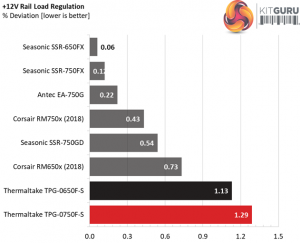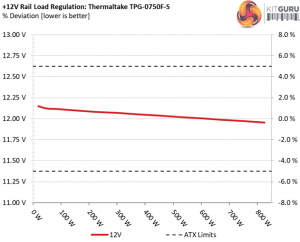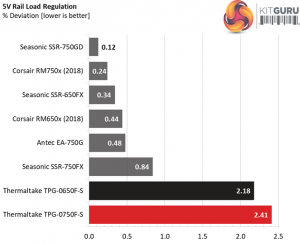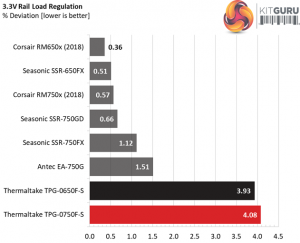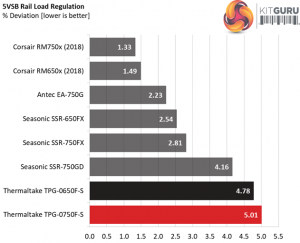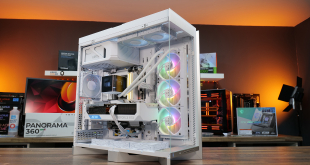To learn more about our PSU tests and methodology, please check out How We Test Power Supply Units.
Primary Rails And 5VSB Load Regulation
Load Regulation testing is detailed here.
Hold-Up Time
Our hold-up time tests are described in detail here.
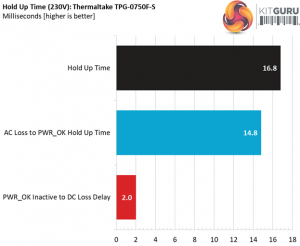
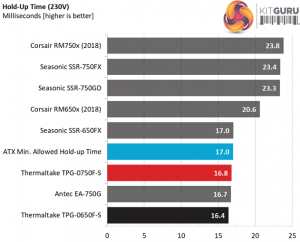
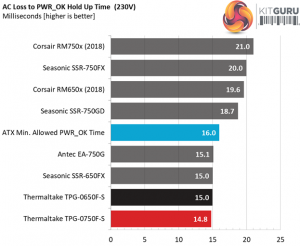
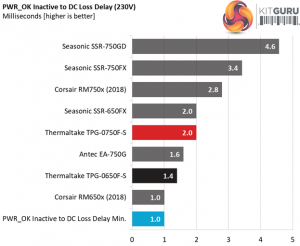
The oscilloscope screenshots that we took during the hold-up time measurements:
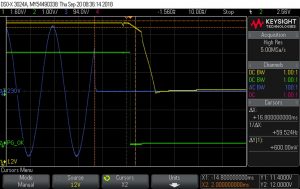
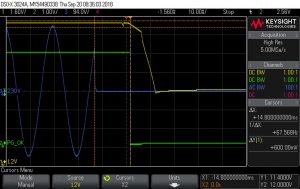
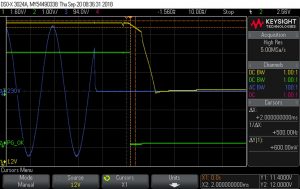
The hold-up is very close to 17ms, with the power ok signal needing 1.2ms to reach 16ms, which is what the ATX spec requires. At least it is accurate (the power ok signal).
Inrush Current
For details on our inrush current testing, please click here.
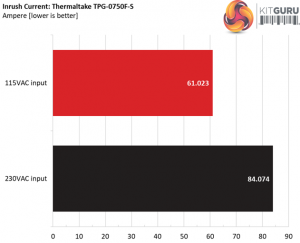
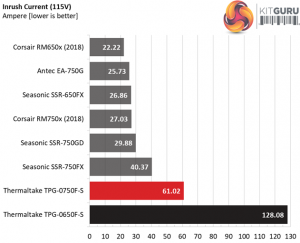
We measure high inrush current with both voltage inputs. What make us wonder here is the sky high inrush reading of the 650W model.
Load Regulation And Efficiency Measurements
The first set of tests reveals the stability of the voltage rails and the TPG-750AH3FSGR’s efficiency. The applied load equals (approximately) 10 to 110 percent of the power supplies maximum load in increments of 10 percentage points.
We conducted two additional tests.
During the first, we stressed the two minor rails (5V and 3.3V) with a high load, while the load at +12V was only 0.1A. This test reveals whether a power supply is compatible with Intel’s C6/C7 sleep states or not. In the second test, we determined the maximum load the +12V rail could handle with minimal load on the minor rails.
| Test # | 12V | 5V | 3.3V | 5VSB | DC/AC (Watts) | Efficiency | Fan Speed (RPM) | PSU Noise (dB[A]) | Temps (In/Out) | PF/AC Volts |
| 1 | 4.371A | 1.982A | 1.957A | 0.999A | 74.578 | 86.843% | 0 | <6.0 | 47.85°C | 0.947 |
| 12.118V | 5.051V | 3.372V | 5.005V | 85.877 | 40.37°C | 115.06V | ||||
| 2 | 9.798A | 2.979A | 2.950A | 1.204A | 149.460 | 90.367% | 0 | <6.0 | 48.87°C | 0.977 |
| 12.099V | 5.038V | 3.357V | 4.985V | 165.393 | 40.83°C | 115.06V | ||||
| 3 | 15.632A | 3.484A | 3.437A | 1.411A | 224.871 | 91.552% | 580 | 9.5 | 41.04°C | 0.990 |
| 12.082V | 5.025V | 3.344V | 4.964V | 245.620 | 49.49°C | 115.04V | ||||
| 4 | 21.417A | 3.988A | 3.962A | 1.619A | 299.656 | 91.526% | 575 | 9.5 | 41.46°C | 0.994 |
| 12.068V | 5.014V | 3.331V | 4.943V | 327.399 | 50.57°C | 115.04V | ||||
| 5 | 26.889A | 5.001A | 4.974A | 1.829A | 374.579 | 90.961% | 575 | 9.5 | 42.17°C | 0.994 |
| 12.052V | 5.001V | 3.317V | 4.923V | 411.802 | 51.90°C | 115.04V | ||||
| 6 | 32.375A | 6.017A | 5.999A | 2.041A | 449.513 | 90.300% | 820 | 19.3 | 42.81°C | 0.995 |
| 12.037V | 4.987V | 3.301V | 4.902V | 497.802 | 52.95°C | 115.04V | ||||
| 7 | 37.913A | 7.038A | 7.029A | 2.254A | 524.782 | 89.565% | 1010 | 26.2 | 43.34°C | 0.996 |
| 12.019V | 4.974V | 3.286V | 4.881V | 585.922 | 54.24°C | 115.03V | ||||
| 8 | 43.458A | 8.067A | 8.072A | 2.471A | 600.128 | 88.721% | 1140 | 29.9 | 43.52°C | 0.996 |
| 12.005V | 4.960V | 3.270V | 4.859V | 676.425 | 55.15°C | 115.03V | ||||
| 9 | 49.398A | 8.591A | 8.593A | 2.475A | 674.639 | 87.966% | 1405 | 36.0 | 44.59°C | 0.997 |
| 11.987V | 4.949V | 3.257V | 4.849V | 766.933 | 56.84°C | 115.03V | ||||
| 10 | 55.142A | 9.121A | 9.157A | 3.126A | 749.882 | 86.975% | 1400 | 36.0 | 45.69°C | 0.997 |
| 11.972V | 4.936V | 3.243V | 4.800V | 862.178 | 58.70°C | 115.03V | ||||
| 11 | 61.509A | 9.140A | 9.191A | 3.135A | 825.120 | 85.936% | 1398 | 36.0 | 46.51°C | 0.998 |
| 11.956V | 4.925V | 3.231V | 4.787V | 960.153 | 60.89°C | 115.02V | ||||
| CL1 | 0.144A | 14.005A | 13.998A | 0.000A | 118.102 | 82.258% | 690 | 13.8 | 42.42°C | 0.974 |
| 12.109V | 5.002V | 3.308V | 5.065V | 143.575 | 52.31°C | 115.05V | ||||
| CL2 | 62.516A | 1.002A | 1.001A | 1.000A | 761.499 | 87.663% | 1395 | 36.0 | 45.54°C | 0.997 |
| 11.970V | 4.968V | 3.286V | 4.916V | 868.668 | 58.44°C | 115.03V |
The load regulation at +12V is a bit loose, at 1.29%. The minor rails fall behind as well, compared to the competition, with the 5V, 3.3V and 5VSB rails registering 2.41%, 4.08% and 5.01% deviations, respectively. Obviously High Power didn't pay much attention in load regulation and this will surely affect the overall performance.
The 80 PLUS Gold requirements are easily met with 20% and 50% loads, while with full load the reading is very close to 87% despite of the tough conditions that we apply. This is an efficient platform which manages to keep the noise output low, even at high loads with the operating temperatures getting close to 47°C. The semi-passive operation doesn't last long once the temperatures start to rise, however the fan profile is very relaxed.
 KitGuru KitGuru.net – Tech News | Hardware News | Hardware Reviews | IOS | Mobile | Gaming | Graphics Cards
KitGuru KitGuru.net – Tech News | Hardware News | Hardware Reviews | IOS | Mobile | Gaming | Graphics Cards


